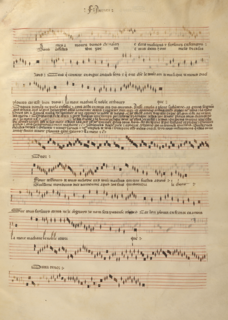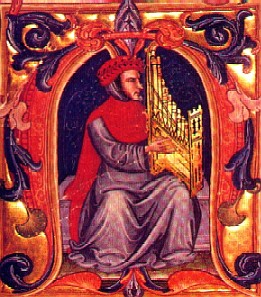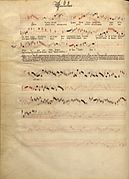- Chantilly Codex, f. 43v (in conventional notation)
- Newberry Library, Ms. 54.1, f.10r (superimposed onto the strings of a harp)
Related Research Articles

The Cantigas de Santa Maria are 420 poems with musical notation, written in the medieval Galician-Portuguese language during the reign of Alfonso X of Castile El Sabio (1221–1284) and often attributed to him.

Renaissance music is traditionally understood to cover music of the 15th and 16th centuries, later than the Renaissance era as it is understood in other disciplines. Rather than starting from the early 14th-century ars nova, the music of the Trecento was treated by musicology as a coda to Medieval music and the new era dated from the rise of triadic harmony and the spread of the ' contenance angloise ' style from Britain to the Burgundian School. A convenient watershed for its end is the adoption of basso continuo at the beginning of the Baroque period.

A clef is a musical symbol used to indicate which notes are represented by the lines and spaces on a musical stave. When a clef is placed on a stave it assigns a particular pitch to one of the five lines, which in turn gives pitch value to the remaining lines and spaces.
Graphic notation is the representation of music through the use of visual symbols outside the realm of traditional music notation. Graphic notation became popular in the 1950s, and can be used either in combination with or instead of traditional music notation. Graphic notation was influenced by contemporary visual art trends in its conception, bringing stylistic components from modern art into music. Composers often rely on graphic notation in experimental music, where standard musical notation can be ineffective. Other uses include pieces where an aleatoric or undetermined effect is desired. One of the earliest pioneers of this technique was Earle Brown, who, along with John Cage, sought to liberate performers from the constraints of notation and make them active participants in the creation of the music.

Ars subtilior is a musical style characterized by rhythmic and notational complexity, centered on Paris, Avignon in southern France, and also in northern Spain at the end of the fourteenth century. The style also is found in the French Cypriot repertory. Often the term is used in contrast with ars nova, which applies to the musical style of the preceding period from about 1310 to about 1370; though some scholars prefer to consider ars subtilior a subcategory of the earlier style. Primary sources for ars subtilior are the Chantilly Codex, the Modena Codex, and the Turin Manuscript.

F. Andrieu was a French composer in the ars nova style of late medieval music. Nothing is known for certain about him except that he wrote Armes, amours/O flour des flours, a double ballade déploration, for the death of Guillaume de Machaut in 1377. The work has been widely praised and analyzed; it is notable for being one of two extant medieval double ballades for four voices, the only known contemporary musical setting of Eustache Deschamps and the earliest representative of the longstanding medieval and Renaissance lamentation tradition between composers. He may be the same person as Magister Franciscus, although the scholarly consensus on this identification is unclear. With P. des Molins, Jehan Vaillant and Grimace, Andrieu was one of the "post-Machaut" generation whose pieces retain enough ars nova qualities to be differentiated from composers of ars subtilior.
Solage, possibly Jean So(u)lage, was a French composer, and probably also a poet. He composed the most pieces in the Chantilly Codex, the principal source of music of the ars subtilior, the manneristic compositional school centered on Avignon at the end of the century.
Paolo da Firenze was an Italian composer and music theorist of the late 14th and early 15th centuries, the transition from the musical Medieval era to the Renaissance. More surviving music of the Trecento is attributable to Paolo than to any other composer except for Francesco Landini.

The Trecento was a period of vigorous activity in Italy in the arts, including painting, architecture, literature, and music. The music of the Trecento paralleled the achievements in the other arts in many ways, for example, in pioneering new forms of expression, especially in secular song in the vernacular language, Italian. In these regards, the music of the Trecento may seem more to be a Renaissance phenomenon; however, the predominant musical language was more closely related to that of the late Middle Ages, and musicologists generally classify the Trecento as the end of the medieval era. Trecento means "three hundred" in Italian but is usually used to refer to the 1300s. However, the greatest flowering of music in the Trecento happened late in the century, and the period is usually extended to include music up to around 1420.
The Saint Martial School was a medieval school of music composition centered in the Abbey of Saint Martial, Limoges, France. Most active from the 9th to 12th centuries, some scholars describe its practices, music, and manuscripts as 'Aquitanian'. It is known for the composition of tropes, sequences, and early organum. In this respect, it was an important precursor to the Notre Dame School. Adémar de Chabannes and his nephew Roger de Chabannes were important proponents of this school.
Jacob Senleches was a Franco-Flemish composer and harpist of the late Middle Ages. He composed in a style commonly known as the ars subtilior.

The Montpellier Codex is an important source of 13th-century French polyphony. The Codex contains 336 polyphonic works probably composed c. 1250–1300, and was likely compiled c. 1300. It is believed to originate from Paris. It was discovered by musicologist Edmond de Coussemaker in c. 1852.

The Chantilly Codex is a manuscript of medieval music containing pieces from the style known as the Ars subtilior. It is held in the museum at the Château de Chantilly in Chantilly, Oise.

The Bamberg Codex is a manuscript containing two treatises on music theory and a large body of 13th-century French polyphony.

Grimace was a French composer-poet in the ars nova style of late medieval music. Virtually nothing is known about Grimace's life other than speculative information based on the circumstances and content of his five surviving compositions of formes fixes; three ballades, a virelai and rondeau. He is though to have been a younger contemporary of Guillaume de Machaut and based in southern France. Three of his works were included in the Chantilly Codex, which is an important source of ars subtilior music. However, along with P. des Molins, Jehan Vaillant and F. Andrieu, Grimace was one of the post-Machaut generation whose music shows few distinctly ars subtilior features, leading scholars to recognize Grimace's work as closer to the ars nova style of Machaut. His most often performed work in modern-times is the virelai and proto-battaglia: A l’arme A l’arme.
Sub Arturo plebs – Fons citharizantium – In omnem terram is an isorhythmic motet of the second part of the 14th century, written by an English composer known by the name of Johannes Alanus or John Aleyn. It stands in the tradition of the Ars nova, the fourteenth-century school of polyphonic music based in France. It is notable for the historical information it provides about contemporary music life in England, and for its spectacularly sophisticated use of complex rhythmic devices, which mark it as a prime example of the stylistic outgrowth of the Ars nova known today as Ars subtilior. It has been dated conjecturally to either around 1358, which, within that school of composition, would make its compositional technique exceptionally innovative for its own time, or some time later during the 1370s.
Jehan Vaillant was a French music composer and theorist. He is named immediately after Guillaume de Machaut by the Règles de la seconde rhétorique, which describes him as a "master … who had a school of music in Paris". Besides five pieces of music surviving to his name, he was also the author of a treatise on tuning. With Grimace and F. Andrieu, Vaillant was part of the post-Machaut generation whose music shows few distinctly ars subtilior features, leading scholars to recognize Vaillant's work as closer to the ars nova style of Machaut.
The Modena Codex is an early fifteenth-century Italian manuscript of medieval music. The manuscript is one of the most important sources of the ars subtilior style of music. It is held in the Biblioteca Estense library in Modena.
P. des Molins, probably Pierre des Molins, was a French composer-poet in the ars nova style of late medieval music. His two surviving compositions – the ballade De ce que fol pensé and rondeau Amis, tout dous vis – were tremendously popular as they are among the most transmitted pieces of fourteenth-century music. The ballade is found in 12 medieval manuscript sources and featured in a c. 1420 tapestry; the rondeau is found in 8 sources and referenced by the Italian poet Simone de' Prodenzani. Along with Grimace, Jehan Vaillant and F. Andrieu, Molins was one of the post-Guillaume de Machaut generation whose music shows few distinctly ars subtilior features, leading scholars to recognize Molins's work as closer to the ars nova style of Machaut.
Petrus de Goscalch was a composer from the papal choir at Avignon of whom only one composition, "En nul estat", survives in the Chantilly Codex, but who may be significant as the possible author of the third part of The Berkeley Treatise of 1375.
References
Strohm, Reinhard – "'La Harpe de Melodie', oder das Kunstwerk als Akt der Zueignung"; in: H. Danuser – Festschrift Carl Dahlhaus zum 60. Geburtstag, Laaber, 1988, pp. 305–16.

